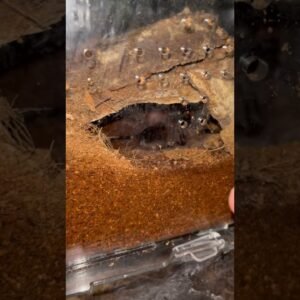Welcome to our blog post! Today, we want to share an interesting and somewhat alarming encounter we had with our tarantula. Imagine our surprise when we found our beloved eight-legged friend in a rather unusual position – upside down! Naturally, we couldn’t help but wonder, is it dead? Join us as we delve into the mysterious world of tarantulas and unravel the truth behind this intriguing situation. Let’s dive right in!
Introduction
Have you ever experienced the heart-stopping moment when you noticed your beloved pet tarantula lying upside down? It’s a common sight that can easily send chills down your spine and trigger a wave of panic. But fear not! In this article, we will unravel the mystery of upside-down tarantulas and address the burning question: Is it dead? So, let’s dive into the fascinating world of tarantula molting and discover why your eight-legged friend might be hanging out in an unconventional position.
Why is my Tarantula Upside Down?
One of the key aspects of tarantula care is understanding their molting process. Tarantulas molt and shed their exoskeletons periodically as they grow. This shedding is crucial for their growth and rejuvenation. During the molting process, a tarantula will lie upside down, seemingly lifeless. Understandably, this can be quite worrisome for pet owners, but it’s important to remember that upside-down tarantulas are not dead; they’re just going through a natural and necessary process.
Leave it Alone
When you notice your tarantula lying on its back, it is crucial to resist the temptation to intervene. Touching, moving, or attempting to feed the tarantula during the molting process can cause severe disturbances and interrupt this delicate stage. Your tarantula needs solitude and a quiet environment to successfully complete the molting process. So, as difficult as it might be, it’s best to leave your tarantula undisturbed.
Patience is Key
After molting, your tarantula may need some time to fully recover and harden its new exoskeleton. It is advisable to wait at least 1.5 weeks before handling or feeding your tarantula again. Rushing this process can be detrimental to your tarantula’s health and may even lead to injury. It’s essential to prioritize their well-being over any eagerness to interact with them.
Clearing the Encore
As a responsible tarantula keeper, it is important to ensure that there are no leftover feeder insects in the enclosure after molting. Your tarantula will need a peaceful environment to regain its strength, and the presence of uneaten prey can cause unwanted disturbances. Make sure to remove any uneaten insects promptly and maintain a clean habitat for your pet.
Newbie Nerves
If you are new to tarantula keeping, witnessing your tarantula upside down for the first time can be quite alarming. However, understanding that this behavior is a natural part of their life cycle can help alleviate any unnecessary panic. Remember that upside-down tarantulas are not dead; they are simply undergoing molting, a normal and healthy process for their growth.
Time to Shed
The molting process typically takes around 6 hours, during which your tarantula will be lying on its back. It might appear motionless and lifeless, but it’s essential to be patient and let nature take its course. Resist the urge to interfere, and trust that your tarantula knows how to handle this process on its own. After the molting is complete, your tarantula will return to its normal position, giving you a sigh of relief.
Upside-Down, Not Discarded
It’s crucial to understand that upside-down tarantulas are not dead and should never be thrown away. This position is a sign that they are molting, and it is vital to provide them with a safe and undisturbed environment. Treating it as a deceased tarantula can lead to unnecessary loss and harm to your pet.
Conclusion
In conclusion, finding your tarantula upside down might be an initial shock, but it’s important to remember that this is a temporary and necessary phase in their lives. Resisting the urge to interfere and providing a calm and quiet atmosphere will ensure the successful completion of their molting process. So, next time you come across your tarantula in an unconventional position, embrace the opportunity to witness nature’s marvel rather than succumbing to panic.
FAQs
-
Is my tarantula dead when it’s lying upside down?
No, your tarantula is not dead but undergoing the molting process. -
Can I touch or move my tarantula during molting?
It is advisable not to touch, move, or feed your tarantula during the molting process. -
How long should I wait before handling or feeding my tarantula after molting?
It is recommended to wait at least 1.5 weeks to allow your tarantula to fully recover before handling or feeding. -
Should I remove uneaten feeder insects after my tarantula molts?
Yes, it’s important to ensure there are no leftover insects in the enclosure after molting. -
What should I do if I’m a new tarantula owner and my spider is upside down?
If you’re new to tarantula keeping, don’t panic when your tarantula is upside down. It’s a natural part of their molting process.
